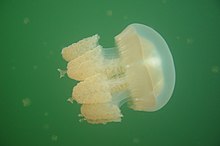Entacmaea medusivora
| Entacmaea medusivora | ||||||||||||
|---|---|---|---|---|---|---|---|---|---|---|---|---|
| Systematics | ||||||||||||
|
||||||||||||
| Scientific name | ||||||||||||
| Entacmaea medusivora | ||||||||||||
| Fautin & Fitt , 1991 |
Entacmaea medusivora is a species of sea anemones (Actiniaria) found in two marine lakes in Palau , including the most famous jellyfish lake Ongeim'l Tketau on the island of Eil Malk , and in Lake Kakaban ( Kalimantan Timur , Borneo, Indonesia). It feeds almost exclusively on medusa, the scyphozoa that are common in these lakes.
features
The columnar body is approximately the same thickness over its entire height in the extended state. The typical length is about 15 mm in height and about 12 mm in diameter. However, the body can be greatly stretched, so that it greatly increases the length to the disadvantage of the diameter. It is translucent with an almost smooth surface. The mesenteries can be seen as slightly lighter lines from the outside, as well as the gonads and the mesentery filaments. The color is somewhat dependent on the prey taken. It is mostly bluish, often pink to slightly brown when cultivated. The base is usually a bit wider, as is the top end. The tentacles are usually thin, colorless and translucent. The distal ends can curl up. They measure about 20 to 25 mm when stretched with a diameter of about 1 mm at the base. The mouth is relatively small (about 1 mm with about 10 mm diameter of the oral disc) and can sit on a small mound. They do not have any zooxanthellae in their tissue. The cnidoma consists of spirocysts, basitriches, holotriches and microbasic p-mastigophores.
Way of life and geographical occurrence
The way of life of the species has been well studied, especially in Ongeim'l Tketau. Entacmaea medusivora is restricted to the shores of the lake to a depth of about 5 m. There it feeds almost exclusively on Medusa, the subspecies Mastigias cf. papua ssp. etpisoni Dawson, 2005. Molluscs (Mollusca) and crustaceans (Crustacea) were also accepted as food under experimental conditions . It is noteworthy that the main prey animals of Entacmaea medusivora are the medusas of Mastigias cf. papua ssp. etpisoni Dawson, 2005 contain many zooxanthellae in their umbrella, which provide the animals with nutrients. Some species of sea anemones, which also feed on medusa, now take over the prey's zooxanthellae in their bodies. In the case of Entacmaea medusivora , however, these are completely digested; the animals live without zooxanthellae. A second occurrence is known from another “jellyfish lake” on the island of Koror, but where the animals live in a far lower density than in Ongeim'l Tketau.
Under experimental conditions, the animals show no behavioral changes when the salt content is lowered to 17 ‰. They can easily survive even lower salt contents (up to about 10 to 12 ‰). They are also very tolerant of low levels of oxygen in the water. The reproductive cycle is also not yet fully known. So far, no division or pinching of the foot has been observed. Under laboratory conditions, large specimens have been observed to release planula-like larvae into the open water from time to time . However, it is not known whether these were produced sexually or possibly asexually.
Entacmaea medusivora was detected for the first time in the small, only 5.7 hectare salt water lake Ongeim'l Tketau on the island of Eil Malk in the South Pacific island state of Palau . The species was believed to be endemic to this lake. This marine lake is stratified and only the top 15 m of the 30 m deep lake are ventilated. The lake is max. 12,000 years old, because it was created by filling a roughly 60 m deep depression in the island's karst rock due to the rising sea level since the last ice age. It therefore seemed to the first authors not unlikely, similar to the three subspecies of Mastigias cf. papua native to Palau , that the species only emerged at this time. In 2014, however, the species was also detected in Lake Kakaban in Kalimantan Timur , Borneo , Indonesia. There it feeds on three species of umbrella jellyfish Mastigias papua , Aurelia aurita (Linnaeus, 1758) and Cassiopeia ornata Haeckel, 1880.
literature
- Daphne Gail Fautin and William K. Fitt: A jellyfish-eating sea anemone (Cnidaria, Actiniaria) from Palau: Entacmaea medusivora sp. nov. In: Hydrobiologia. 216-217, 1991, p. 453, doi : 10.1007 / BF00026499 .
Individual evidence
- ^ A b c Bert W. Hoeksema, Yosephine Tuti, Leontine E. Becking: Mixed medusivory by the sea anemone Entacmaea medusivora (Anthozoa: Actiniaria) in Kakaban Lake, Indonesia. In: Marine Biodiversity. 45, 2015, p. 141, doi : 10.1007 / s12526-014-0233-4 .
